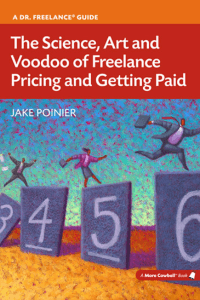 Dr. Freelance: You have probably heard this before, but I constantly look at the going freelance rates for a project on one of the industry rate charts, add up the average per page/word costs, then think, “I can’t charge THAT!” So I end up underpricing myself and throwing in freebies such as marketing plans and so on.
Dr. Freelance: You have probably heard this before, but I constantly look at the going freelance rates for a project on one of the industry rate charts, add up the average per page/word costs, then think, “I can’t charge THAT!” So I end up underpricing myself and throwing in freebies such as marketing plans and so on.
I am aware of the danger of undervaluing my work, but I have really yet to find a client who understands the value in what they are receiving and are willing to pay full price. I recently lost out on an editing project, which I’d priced at $1,500 for 80 hours, to another editor who charged $400. I understand that I need to do a better job of pricing accurately, but how do I avoid losing work to someone who’s supplementing their retirement income with a few dollars?—Shooting Myself in the Foot
Yes, Foot-Shooter, you’re undervaluing your work. Badly. The first step to recovery is acceptance, so now let’s talk about what you can do about it.
- Never worry about others lowballing a project. They’re not your competition. $400 for 80 hours is ridiculous, and I imagine the author got exactly what he or she paid for: garbage. (As you admit, $1500—which works out to $18.75 an hour—was far too low, too.) There are plenty of authors and clients who aren’t going to recognize the value. You need to be willing to walk away and not concern yourself. In some cases, they may come crawling back to you, but you need to be confident and stick to your guns—don’t drop your price or toss in freebies without a quid pro quo.
- Go beyond freelance rate sheets. At the recent Communication Central 2015 conference, I was speaking to a colleague who made an interesting comment: freelance rate sheets use circular logic that promotes lowballing (i.e., low prices beget low prices). I’d never thought about it that way, but she’s right. I don’t want to sound harsh, but depending on rate sheets alone for freelance pricing is also lazy. Do some research among your successful peers in your target markets. Finally, these freelance rate calculators can help you formulate the numbers based on your own income requirements or earning aspirations.
- Avoid competitive situations. I go into significant detail about this principle in The Smooth-Sailing Freelancer (available here as a free ebook), so I won’t belabor the point in this post. But the short version is that you’re undermining your business prospects if you are only seeking business through job lists or bidding sites alongside a million other freelancers. You need to go where there’s less competition—or preferably, none at all!
- Leverage social proof. This isn’t an instant fix, but will help over the long term. Solicit some testimonials/LinkedIn recommendations from some of your clients who have been at a decent rate and been satisfied with your work; i.e., someone who can attest to the value you deliver—and have them say that explicitly in their recommendation. You want a prospective client to “see themselves” as a potential beneficiary of your good work. If you have an author whose book has done well in the marketplace, that would be another item to emphasize.
Make the Sale Before You Name a Price
I want to call your attention to why that final bullet is so important: You need potential clients to want to work with you BEFORE you ever name a price! People will want to know what it’s going to cost up front; it’s human nature. But the more you can get them to understand that you will make their project sing, the more willing they will be to pay higher rates. If someone asks you what your price is before you know the whole story, you don’t have to answer immediately; in fact, doing so is counterproductive. Be patient, and explain that you’ll need to see a sample of the manuscript or a detailed outline of the project tasks before you can formulate a price. Don’t be afraid to ask about their budget range, or what they’ve paid for previous types of projects in the past.
A smart client will understand that professional editing or writing is essential, and worth the investment. Conversely, no matter how much convincing you do, a foolish one won’t—and will cause you heartache in the process.
 The Science, Art and Voodoo of Freelance Pricing and Getting Paid offers a more detailed explanation of how to crunch the numbers, formulate persuasive estimates, and give yourself more leverage in negotiations with potential freelance clients.
The Science, Art and Voodoo of Freelance Pricing and Getting Paid offers a more detailed explanation of how to crunch the numbers, formulate persuasive estimates, and give yourself more leverage in negotiations with potential freelance clients.
Already read it? I always appreciate reviews on Amazon and Goodreads—thank you!
Just went thru this — Nutshell version: about 5 years ago, did a high-volume content project for a return client. He balked at $50 per article,which was already a steal, and so I caved in because of the volume and did it for $25/per article.
Big mistake. I ended up doing boatloads of work for barely minimum wage. Yes, the final check was substantial because of the volume – but the amount of work involved was humungous.
Fast-forward to 2015: same client wanted similar project. I bid at average of $200 per article. He gulped “wow, that’s way higher than five years ago” – I said, yes it is, but here’s what’s involved – brief yadas – and ending with, “and that takes time, and time is $$, so that’s why it’s now $150. Love to work w/you again, let me know…etc.”
He came back with ‘fine, let’s get going”.
He’s a quality client and I know he realizes if he wants CraigsList quality, my team and I aren’t it. He wants high quality and is willing to pay a reasonable amount for it.
Either way, I was not remotely tempted to do the project for less than $200 per article again.
Thanks for sharing that anecdote, Paula. In particular, thank you for demonstrating that you most certainly can and should revise your pricing—even with an existing client—to reflect the actual amount of work! Great stuff.
Thank you for the mention of the Communication Central conference (www.communication-central.com) – as usual, you were a wonderful factor in its success!
And yes, this person is seriously underpricing and apparently looking for work in all the wrong places. I don’t even go to sites where we have to bid for work, whether it’s writing, editing, proofreading, whatever. It takes more time and effort, but we have to look for clients who understand the value and benefit of using a professional with strong skills and experience. They do exist, but not on most (if any) job sites. They show up in listings from professional membership associations but also in independent efforts. Sometimes local businesses and firms are great sources of work that pays well, and those contacts can lead to work from similar entities in other locations.
I’m lucky enough to be able to say to the lowballers something like, “I’m sure you can find someone who charges less than I do, but be aware that you might end up working with someone who also is less skilled and less experienced. I wish you the best of luck. If the other person doesn’t work out, feel free to get back in touch.” When they come back, as some of them have, my rate just might be even more than the original quote.
Thanks for commenting, Ruth. As I mentioned in my referrals workshop at Communications Central, it’s often amazing how much desirable your services become when you reject someone! Thanks again for inviting me to present. 🙂